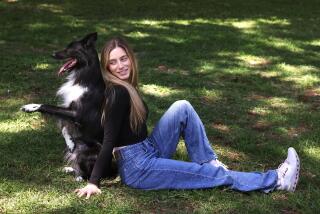Back in step with that old shuffle
- Share via
When I was a kid, I’d pull on a black leotard and pink tights and make the best sound ever: the shuffle-shuffle-shuffle of my tap shoes on our tiled kitchen floor. Step-ball-changing to “The Muppet Show” theme seemed so Broadway, so grown-up -- at age 5.
Then came adolescence, and tap-dancing felt anything but adult. Recently I journeyed to Long Beach to see if I could reawaken a childhood interest that, a decade earlier, had me stomping to a song from “Sister Act” in a green-sequined dress. Bored with treadmills and tired of the gym, I also wanted to shape an adult body that rarely dances.
That brings me to Jennifer Seigle’s tap class one recent evening, in which 18 students -- all women -- heel-step as half a dozen mirrors capture each “oops” or satisfied smile. Students sport cut-off sweats, tight black pants, even jeans. A few slide in socks on this first meeting of a twice-weekly Long Beach City College class.
Seigle, also trained in modern dance, ballet and musical theater, leads us through 15 minutes of stretching and basics. Tap, tap, tap with the ball of the foot. Then a flap -- a brush and tap that sound the way dancers pronounce it: fahlap. In the cacophony, my toes wriggle in memory, like how your mind hunts for lyrics to a once-familiar song.
“You getting this?” asks a woman fahlapping next to me.
“Sure.” Ugh.
I’m on the wrong foot.
During the semester, Seigle, 29, will dance the gals through Fred Astaire and Savion Glover (“Bring in ‘Da Noise, Bring in ‘Da Funk”). They’ll improvise sounds, like jazz musicians with instrumental shoes, and rehearse steps that progress in intricacy.
The artistic director of Beacon St. Dance Project, a modern dance company in Los Angeles, Seigle learned tap for a role in “42nd Street” as a teenager in New Hampshire.
“There’s something about shoes that make noise,” she says, “that instantly makes you a kid again.”
Seigle herds us to the back of the room for what my old dance teachers called progressions, or corner-to-corner combos. Most are simple struts in groups of three and four. While you wait, Seigle advises, keep your feet going. You can only lean on the barre if someone’s serving martinis.
The pause leaves me time to check my heart-rate monitor: I’m at 120 beats per minute. Like yoga, tap is a sneaky workout. You may feel your breath quicken or forehead moisten, but because your mind is trying to untangle the steps, you’re distracted. (The morning after my class, my aching rear end answered the question of how good a workout tap-dancing can be.)
I whisper to Rebecca Fast, 30, an eighth-grade history teacher, how long it’s been since I last did this. Her ponytail bobs in agreement as she recalls her last go-round: “Yeah, the first George Bush was president.”
Like me, she’s here to wrest her body into tap-dance shape. Fast dug her shoes out of a closet in her parents’ house. She hung onto them because they’re higher heeled, a rite of passage for tapsters, if out of vogue now.
Tap is a mishmash of British Isles folk dancing and West African rhythm that soared in status during the 1930s -- the Shirley Temple era. Mothers signing up little girls for tap -- and, one can assume, banana curls -- infected the nation.
The dance form’s stock fell with television, theater closures and ballet-inspired choreography, says Rusty Frank, author of a 1995 book about tap-dance stars, and rose again with Gregory Hines’ movies and Glover’s noise and funk.
A beginning tapper typically needs to round out her workout with abdominal and shoulder exercises to get her whole body yelping the next day. Competent dancers can synchronize their appendages and suck in their tummies, but the rest of us try really hard not to trip.
We watch Seigle sashay across the floor with cabaret sizzle, and she instructs us to follow and ooze like “gooey caramel.”
We’re daunted -- “Can we go back to fahlaps?” Fast asks -- but enough in the groove that when one gal slips and goes splat, she peels herself up to a giggling chorus that sounds like a little girl’s slumber party.
“You get addicted,” Anna Robles, 23, tells me after class. She’s tapped at the community college for a year. “You come back next semester, and you’re tapping all the time, and your feet can’t stop moving.”
Our ensemble trots to center to finish our 90 minutes to a showy big band score. My heart is pounding at 142 beats per minute.
We buffalo-step and twirl and shoot out jazz hands. We heel-heel-step-step as a troupe, eyeballing judgmental mirrors.
My tapping is floppy. But after cooling down, packing up the heels and stopping for gas before driving home, I notice something.
I am gripping the unleaded pump. My right foot is shuffling.
*
(BEGIN TEXT OF INFOBOX)
Take the first step
There’s no single online clearinghouse for tap-dancing, but several websites can help you find local classes and other related information.
* Long Beach City College links to a class schedule at tdf.lbcc.cc.ca.us. Many area institutions offer classes, including Glendale Community College, www.glendale.cc.ca.us/dance/index.htm, and L.A. City College, www.lacitycollege.edu/comsvcs/ (click on “Classes,” then “Dance”).
* Los Angeles Choreographers and Dancers, www.lachoreographersanddancers.org, lists dance companies under “Southern California Dance Directory.”
* National Tap Ensemble, a national tap dance company, offers a nice variety of information at its website, www.usatap.org. The site even posts answers to tap-dancers’ questions, such as “What’s the difference between a stamp and a stomp?”
* TheaterDance.com offers a dictionary for tap-dancers at www.theatredance.com/dictionary.html. The homepage links to a history of tap dance. The history section says the term “tap dance” first appeared in print in 1928.
* Tap Dance Homepage, www.tapdance.org, links to tap media, some studios and an international calendar of events.
-- Ashley Powers


